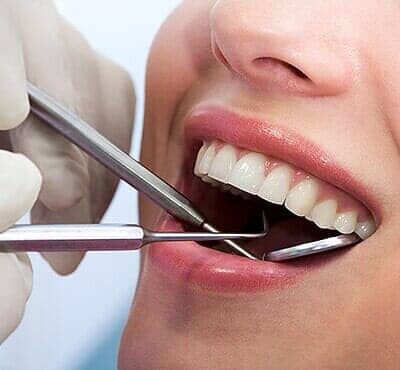Non-Surgical Gum Therapy in Moorpark, California
After a thorough periodontal screening
and examination you might need more aggressive therapies.
Gum Disease
Healthy gum tissue fits snugly around each tooth. It can be harmed by plaque, a sticky film of bacteria that forms on teeth and along the gum line. Bacteria in plaque create toxins that irritate gum tissue.
The early stage of periodontal disease is called gingivitis. Patients with gingivitis may experience gums that are red, swollen and bleed easily. The good news is that this early stage of periodontal disease is reversible.
However, if it's not treated promptly, it may lead to a more serious condition called periodontitis.

During this more advanced stage, the bacterial irritation causes the gums to pull away from the teeth. Instead of a snug fit, the loose tissue now forms pockets that collect more plaque bacteria. The infection, which is sometimes painless, can destroy gum tissue and the bone that supports teeth. Unless periodontitis is treated, teeth may become loose, fall out, or they may need to be removed.
Recent research suggests there may be a link between gum disease and other health concerns such as cardiovascular problems, stroke, diabetes, bacterial pneumonia and increased risk during pregnancy.
When plaque is not removed daily, it absorbs minerals found in saliva. The minerals form a rough, hardened material called calculus, or tartar. Once tartar sticks to the teeth, it can only be properly removed by a professional cleaning in the dental office.
Tartar that is not removed becomes a "plaque trap", holding more bacteria and making it difficult to keep teeth clean. Patients are encouraged to brush their teeth at least twice daily and floss or use an interdental cleaner once a day to help keep their mouths clean and healthy.
The Warning Signs
It's possible to have periodontal disease and have few warning signs. That's one reason why it's important to have regular dental visits and professional teeth cleaning. Routine dental visits make it possible for Dr.Sanchez
to treat problems in the early stages.
If you notice any of the following signs, see us immediately:
- Gums that bleed during tooth brushing
- Red, swollen, and/or tender gums
- Gums that have pulled away from your teeth
- Persistent bad breath
- Pus between the teeth and gum
- Loose or separating teeth
- A change in the way your teeth fit together when you bite
- A change in the fit of partial dentures
Pain can occur in advanced stages or in rapidly progressing forms of the disease. Do not wait until it hurts as a combination of regular professional treatment and home care will help keep your smile healthy.
Treatments for gum disease that don't involve surgery include:
-
Professional Dental Cleaning :
during a typical checkup our hygienist will remove the plaque and tartar from above and below the gum line of all teeth. If you have any signs of gum disease, Dr.G.Sanchez
and the hygienist may recommend professional dental cleaning more than twice-a-year.
-
Scaling And Root Planing :
This is a non-surgical deep-cleaning procedure, done under local anesthetic, whereby plaque and tartar from above and below the gum line are removed (scaling) and rough spots on the tooth/root made smooth (planing). Smoothing the rough spots removes bacteria and provides a clean surface for the gums to reattach to the teeth.

Surgical Gum Therapy
Some treatments for gum disease are surgical. Some examples are :
-
Flap Surgery/Pocket Reduction Surgery :
During this procedure the gums are lifted back and the tartar is removed. In some cases, irregular surfaces of the damaged bone are smoothed to limit areas where disease-causing bacteria can hide. The gums are then replaced so that the tissue fits snugly around the tooth. This method reduces the size of the space between the gum and tooth, thereby decreasing the areas where harmful bacteria can grow and decreasing the chance of serious health problems associated with periodontal disease.
-
Bone Grafts :
This procedure involves using fragments of your own bone, synthetic bone, or donated bone to replace bone destroyed by gum disease. The grafts serve as a platform for the regrowth of bone, which restores stability to teeth.
-
Guided Tissue Regeneration :
Performed when the bone supporting your teeth has been destroyed, this procedure stimulates bone and gum tissue growth. Done in combination with flap surgery, a small piece of mesh-like fabric is inserted between the bone and gum tissue. This keeps the gum tissue from growing into the area where the bone should be, allowing the bone and connective tissue to regrow to better support the teeth.
-
Bone Surgery :
Smooths shallow craters in the bone due to moderate and advanced bone loss. Following flap surgery, the bone around the tooth is reshaped to decrease the craters. This makes it harder for bacteria to collect and grow.
-
Gingivectomy Or Gingivoplasty :
means excision of the gingiva. By removing the pocket wall, gingivectomy surgery provides visibility and accessibility for complete calculus removal and thorough smoothing of the roots, creating a favorable environment for gingival healing and restoration of a physiologic gingival contour.
-
Crown Lengthening :
is a surgical procedure performed to expose a greater amount of tooth structure for the purpose of subsequently restoring the tooth prosthetically.
